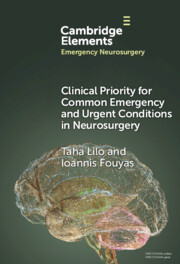Element contents
Clinical Priority for Common Emergency and Urgent Conditions in Neurosurgery
Published online by Cambridge University Press: 04 April 2024
Summary
Keywords
- Type
- Element
- Information
- Online ISBN: 9781009440615Publisher: Cambridge University PressPrint publication: 18 April 2024
References
- 4
- Cited by

